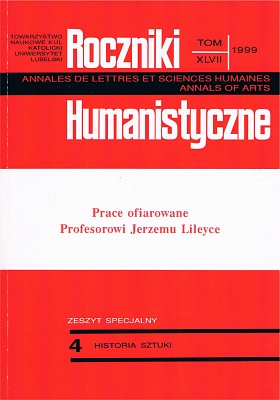Model stołecznego miasta europejskiego
Abstrakt
A sense of cultural-civilisation unity and communication with Europe is the cause why we do not treat our endeavours to join the European Union as entering a foreign structure, but as a return to the Mother-Europe, as a renewal of our participation in a greater European homeland.
There is a model of the European capital city. To what degree does Warsaw meet the conditions contained in the synthetic model of a European capital city? In the model we will consider the town-planning structure, that is its topographic arrangement, composition, form and standard, and also those elements that distinguish a capital city.
Natural factors are climatic conditions and topography, that is the situation in the geographical space. The climatic conditions of European capitals are similar and they are the reason why the climatic factor does not impose substantially different architectonic-urban patterns, on the contrary, it allows a transfer of urban solutions from one continent to another, becoming a factor that introduces unification of the structures. There is a greater differentiation in topographic conditions. Model conditions are met by those capitals that are situated inland and on rivers; these are the conditions that are necessary for developing the urban-architectonic structure of a capital city.
The next condition for a model European capital is a clear participation of a historical process. A city, and especially a capital city, is history expressed in space and buildings. Without history, which has to go back to times earlier than the 20th century, there is no capital deserving to be called European. Historicity of capitals is expressed in the space structure of the city area, and more precisely, in the participation of the old part of the city (Old Town) and in its location in relation to the centre and to the whole town. The ideal, or model state, is one in which the old town has remained the central area in the modern town and around it the later and modern centre is built, and then suburbs grow in a ring-like manner.
History is revealed in the ring-like arrangement of great streets, which like rings in a tree grow around the kernel, and the kernel is almost always the castle or the royal palace and the cathedral built close to it. In the ideal arrangement a river is always the bowstring for the arches; on it or close to it there are always buildings housing the centres of both lay and spiritual authority. In this way the ring-radial arrangement is spatially translated into the town's two features: chronology of development and hierarchy of its parts.
From the very beginning, the town and its centre has to accept a proper space scale. The concentric development around the Old Town results in the town maintaining spatial compactness and a harmonious density of buildings, which decreases as it gets farther from the centre. Owing to this the urbanised silhouette of the town assumes the form of a compact blot, which is a necessary requirement for a model European capital.
In the territory of the town special places of urban concentration must be singled out. Two areas of urban concentration may be pointed to: prestige routes and ceremony squares. Prestige routes in a European capital city are a territory that is built up in a natural way. The capital lives with the history of the country and it reshapes the history into the urban-spatial arrangement along a communication route. After some time its function as a communication route recedes to the background, and architectural-visual elements, which are documents of history, become the most significant. The prestige route is then the greatest concentration of the capital quality, it is the capital of the capital.
Besides prestige routes squares are an area of urban concentration in the capital, and especially squares of a certain type that can be called ceremony squares. These are the places where the state ceremonies take place.
Another element of the capital quality in Europe are representative parks. They are a prolongation of attributes of power and in the past epochs they were part of the rulers' residences. Besides intra-urban parks, the rulers' suburban residences must be included in the European model of the capital.
The next elements of the model of the European capital are important public buildings housing state and social institutions. A set of these buildings, their choice and location in the city, are a canon of the capital quality. They symbolise the state authority, both lay and spiritual, the town authority, culture and art, knowledge and science, justice, communication and money.
A feature of the model European capital is the visual decoration made up by sculpture, a second urban branch of art, besides architecture. In European cities monument sculpture is developed, which shapes their visual image and testifies to the national history, decorative sculpture, and religious sculpture, where statues of the saints make squares and streets sacred.
A town is the work and image of history and culture of a given nation, country, state. There are circumstances that can weigh on the development of the town. Did subsequent generations agree to accept history and recognise its continuity, or did they break up with the past and want to give the town a new shape? Secondly, in what epoch and under the rule of what kind of art did the town experience its best time? And thirdly, what was the role of the patron-ruler in shaping the European capital city?
Warsaw may be included, albeit hardly, in the model of the European capital. In it we have all the important elements that are decisive for the model. However, its history did not allow it to be fully shaped according to the European standards. Approaching Europe, joining its institutional structures, should be an obligation for us to undertake a great programme of valorisation of our capital.
Copyright (c) 1999 Roczniki Humanistyczne

Utwór dostępny jest na licencji Creative Commons Uznanie autorstwa – Użycie niekomercyjne – Bez utworów zależnych 4.0 Międzynarodowe.





